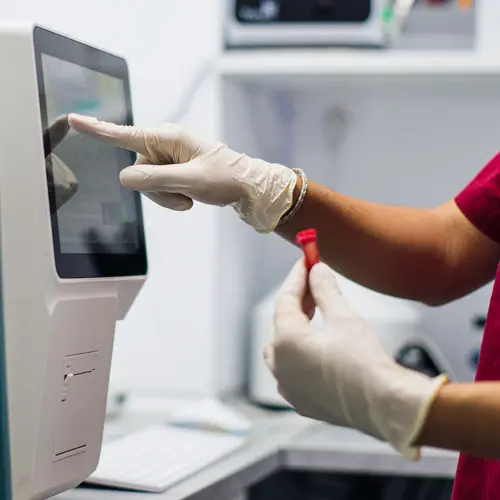When you have Crohn’s disease, inflammation doesn’t always stay in your digestive tract. Up to half of people with Crohn’s also have inflammation in their eyes or other parts of the body. Your doctor might call these symptoms extraintestinal manifestations or EIMs.
Eye inflammation is the third most common type of EIM. It’s important to see an eye doctor (an ophthalmologist) as soon as you notice any changes in your vision. Regular eye exams are also key. They can catch eye complications early and possibly spot other health problems before symptoms show up.
Does Crohn’s Disease Cause Eye Problems?
A few factors likely trigger eye problems in people with Crohn’s. These include:
Immune response. Crohn’s disease can damage the lining of your intestine. This allows toxins and proteins called antigens to leak from your digestive tract into your bloodstream. Your immune system sees these substances as harmful and attacks them, just like it attacks your intestine. This can trigger inflammation in your eyes and other parts of your body.
Family history. Studies suggest a family history of Crohn’s may make eye inflammation more likely, even if you don’t have genes linked to the disease.
Oral steroids and other medicines. Some treatments for Crohn’s disease can lead to eye problems. Steroids you take by mouth raise your odds of glaucoma or high pressure in the eye. They do the same for cataracts, which cloud the lens. Tumor necrosis factor (TNF) blockers such as infliximab (Remicade) and etanercept (Enbrel) may trigger an eye condition called uveitis. If you take these medicines, ask your doctor how often you should have your eyes checked.
Sometimes eye inflammation shows up before intestinal symptoms. If you have many bouts of eye inflammation, talk to your doctor about screening for Crohn’s disease.
What Are the Risk Factors for Crohn’s and Eye Problems?
Anyone with Crohn’s can get eye inflammation. It’s more likely if you:
- Were assigned female at birth
- Have symptoms mainly in your colon
- Have frequent flare-ups
- Are older
- Have arthritis or other health problems
What Eye Problems Does Crohn’s Cause?
The main eye problems that can happen with Crohn’s are:
Episcleritis. This is inflammation of the white part of your eye called the sclera. It’s usually not painful but can make your eyes look red and irritated. Episcleritis seems to follow inflammation in your gut. In other words, when your Crohn’s flares up, episcleritis does, too. It goes away when your gut calms down. It usually doesn’t need treatment, but a cool compress or lubricant eye drops (also called artificial tears) can help.
Scleritis. This rare type of eye inflammation may look like episcleritis, but it’s much more painful and serious. The most common treatment is nonsteroidal anti-inflammatory drugs (NSAIDs) like ibuprofen. These aren’t the best choice for people with Crohn’s, though. Although NSAIDs suppress inflammation, they also rob the digestive system of substances that protect it. If your symptoms are severe, your doctor may prescribe steroid pills.
Uveitis. This is inflammation of the uvea, the middle layer of the eye between the sclera and the eye’s inner layers. It’s one of the most common eye problems in Crohn’s disease, but doesn’t usually track with other symptoms. If your Crohn’s flares, that doesn’t mean uveitis will. Warning signs like redness, pain, and blurred vision can come on suddenly in one or both eyes.
There are four types of uveitis. The type you have depends on where the swelling is:
- Anterior uveitis, also called iritis, is the most common form and affects the front of your eye.
- Intermediate uveitis affects the retina – the part of your eye that sends signals to your brain that help you see.
- Posterior uveitis inflames the back of your eye.
- Panuveitis is when you have inflammation all through your eye. It’s the most serious type of uveitis and hardest to treat.
The goal of treatment is to lower inflammation in your eye and other parts of your body. If you have anterior uveitis, steroid eye drops may do the job. For other types of uveitis, your doctor may prescribe steroid pills or drugs that suppress your immune system. These treatments could trigger new eye problems like glaucoma and cataracts, so be sure to see your eye doctor for regular checkups.
Dry eye disease. In dry eye disease, you may not make enough tears to keep your eyes moist. Or your tear film might dry out too fast. You might have symptoms such as:
- A burning or stinging feeling in your eyes
- Red eyes
- Sensitivity to light
- Trouble driving at night
- Watery eyes (when your body tries to make up for the dryness)
Lots of things can cause dry eyes, like older age, dry air on a plane or in an office, smoking, and too much screen time. Crohn’s disease can also affect the glands that make tears.
The most common treatment is lubricating eye drops, also known as artificial tears. These are not the same as eye drops for redness. Those can make the problem worse. If your eyes are very dry, you may need to use artificial tears a few times a day, even when you don’t think you need to. Your doctor may also suggest an eye ointment at night.
Other treatments for dry eye include:
- Nasal sprays that work like eye drops but may be easier for some people to use
- Eye drops to control inflammation on your eyelids or cornea – your eye’s clear outer layer
- Medicine that helps you make more tears
- Plugs for your tear ducts
- Light therapy and eyelid massage
At home, try:
- A humidifier in your bedroom in winter or year-round in a dry climate
- Warm compresses to cleanse your eyes and soothe inflammation
- Omega-3 fatty acid or fish oil supplements – they can improve the eye’s oil film.

